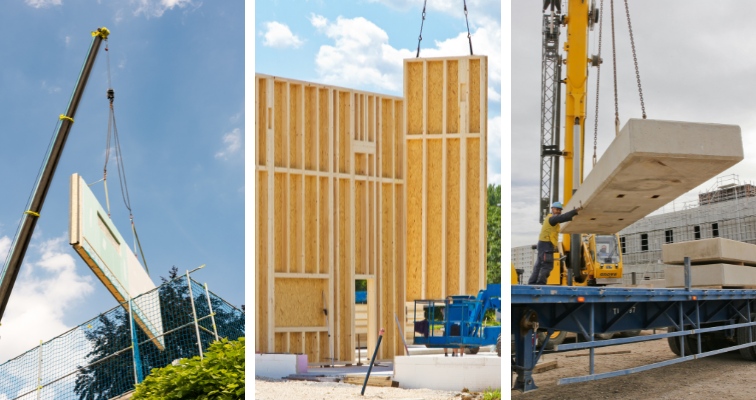In the years following the Second World War, prefabricated construction methods became popular because they offered faster completion times and high-quality control standards. This approach to construction includes various forms such as modular construction units, panelized systems, and pre-manufactured cassettes that builders can efficiently integrate into the construction process.

While many myths and poorly constructed arguments against prefab building methods exist, we dispel many of them in today’s article. We explore how prefab methods affect project timelines and quality control while also addressing the logistical and coordination considerations. Plus, we drop some insight into how construction cameras can improve the entire process.
The Benefits of Prefabricated Construction
Prefabricated construction offers several advantages over traditional construction methods that shift how companies execute building projects. Here’s what makes prefab such an innovative option and how these benefits create a more sustainable built environment.
Accelerated Project Timelines
Prefabricated buildings reduce overall construction timelines by manufacturing building components at the same time as site preparation. While workers prep foundations on the building site, workers assemble wall panels, structural elements, wiring, and some plumbing off-site in factory settings. These concurrent operations cut project completion times down by up to 50%.
Improved Quality Control
Manufacturing components in a controlled factory environment enables more precise quality checks and consistent assembly at every stage. Controlled settings shield components from adverse weather conditions and allow for more thorough inspections of critical assets, like electrical wiring and structural weak points.
Minimized Material Waste
The prefabrication process dramatically reduces material waste through exact specifications and optimized manufacturing processes that maximize the use of raw materials. Precise calculations of material needs and scrap recycling within the factory setting, as well as prefab projects, contribute to a more environmentally friendly construction industry while potentially offering cost savings for the parties involved.
Enhanced Jobsite Safety
Off-site manufacturing of prefabricated components improves worker safety by moving complex assembly processes, such as heights and exposed building sites, to ground-level factory floors. This shift reduces common on-site hazards like falls, machinery accidents, and injuries from handling heavy materials, creating safer working conditions for construction professionals while minimizing disruption to the surrounding environment.
Adaptability to Diverse Environments
Prefabricated construction techniques excel in challenging locations where traditional construction methods might struggle due to limited access or harsh conditions. Companies can manufacture off-site structural elements that they can quickly transport and assemble on-site in remote areas, extreme climates, or densely populated urban environments.
Navigating the Disadvantages of Prefabrication
While prefabricated construction offers significant benefits, it’s important to know the potential downsides, risks, and challenges that come with this approach. Here are some key considerations construction professionals must address when implementing prefab models in their projects:
Logistical Hurdles & Transportation Costs
Moving large prefabricated components from manufacturing facilities to the building site presents complex logistical challenges that require careful planning and coordination. The transportation of complete building sections or wall panels often necessitates special permits, oversized vehicles, and specific route planning, potentially adding unexpected costs to the prefab project that were not originally in the early budgeting stages.
Design Constraints & On-Site Adjustments
Prefab techniques sometimes limit architectural flexibility, as building elements must conform to transportation size restrictions and assembly process limitations. When clients need changes during construction, modifying pre-manufactured cassettes and structural elements is more complicated than adjusting traditional construction materials on-site.
Upfront Investment Considerations
The prefabrication process often incurs higher initial costs for design, engineering, and manufacturing building components before any visible construction progress begins. This front-loaded investment pattern may strain initial cash flow for construction projects on tight budgets or uncertain financing.
Critical Coordination & Integration
Successful prefab construction depends on exceptional coordination between off-site manufacturing and on-site assembly teams. Even minor measurement errors or miscommunications between parties can lead to significant complications or delays, making solid project management and clear communication a must-have for prefab project deployment.
Risk of Damage During Transit & Installation
Prefabricated components face vulnerabilities during transportation from the factory setting to the job site. During transit, compromised structural integrity is a constant worry. Additionally, specific building codes and quality assurance requirements may vary between manufacturing locations and construction sites. These requirements mean prefabricated structures must meet or exceed standards in both environments to ensure long-term structural performance.
Optimizing Prefab Construction with Visual Intelligence
Oversight is the most effective way to verify that prefabricated materials and buildings leave the factory floor with the highest quality possible. Construction cameras are practical solutions, especially when you can’t physically monitor progress, as they monitor and document the entire process, even remotely.
- Streamlined Logistics: Cameras like those provided by TrueLook offer real-time visibility of component staging, loading, and departure from the factory while monitoring arrival and handling on the construction side.
- Enhanced Quality Control: Visual systems document the fabrication process for quality assurance and enable remote inspection capabilities to identify potential issues early in the manufacturing process.
- Efficient On-Site Assembly: Live views of the assembly process allow project managers to monitor integration of prefabricated components and create time-lapse documentation for progress tracking, issue resolution, and even marketing materials.
- Mitigating Security Risks: Construction cameras secure prefabricated modules and materials stored on-site against theft and vandalism while providing visual evidence in case of incidents.
Want to see how construction cameras unlock greater visibility? Check out our live cameras to witness firsthand how jobsite visibility improves construction processes and client satisfaction!
Deploying Remote Monitoring for your Prefab Projects
Getting started with remote monitoring during prefab projects doesn’t have to be overwhelming. Here are five actionable steps to incorporate remote monitoring for enhanced visibility, quality control, and project management:
- Start with strategic camera placement: Position fixed cameras to monitor critical areas where crews will assemble prefabricated components on site, and place additional cameras at entry/exit points to track material deliveries and maintain jobsite security.
- Establish monitoring at manufacturing facilities: Install cameras in the controlled factory environment where manufacturers build elements to document quality checks, assembly processes, and preparation for transportation to the building site, if possible.
- Integrate with project management tools: Connect your remote monitoring system with existing project management software to create a comprehensive view of your construction timeline, helping all parties involved track progress from manufacturing through final assembly.
- Create a documentation strategy: Develop clear protocols for using time-lapse footage and live viewing to document key milestones, quality assurance procedures, and adherence to building codes throughout the prefab project.
Success Story:
TrueLook x Procore Integration
Learn how Harper General Contractor’s enabled 1-Click Access to TrueLook within Procore.

With these remote monitoring strategies in place, construction teams can better manage the unique complexities of prefabricated construction. Firms with construction cameras in place maximize the benefits this innovative method offers for creating a sustainable built environment while mitigating outside risk.
Prefabrication Optimized: Building Efficiency with TrueLook
Prefabricated construction offers many advantages, such as time savings, quality consistency, and reduced material waste. However, coordinating transportation and final assembly can feel like pulling teeth. Despite the challenges, construction cameras provide the visibility you need to pull off prefab construction projects with ease.
Ready to improve your prefab visibility? Connect with a TrueLook expert to create a personalized solution for your prefabricated construction needs.

